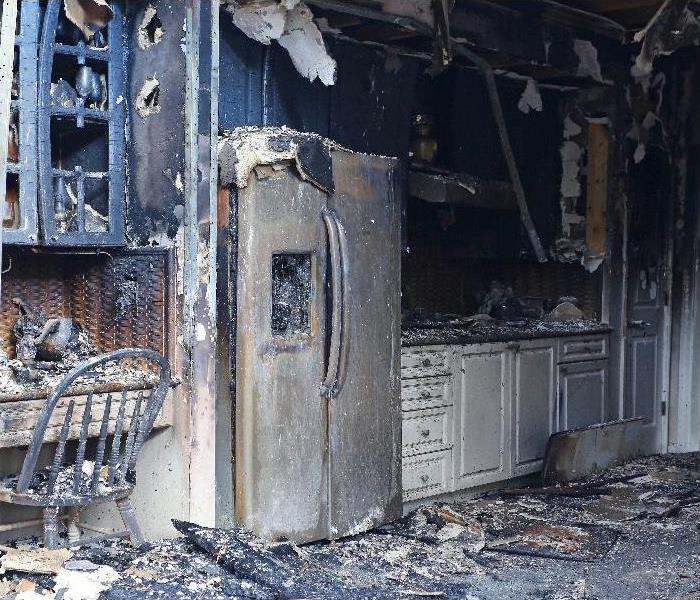What Type of Cleaning is Necessary After Fire Losses in My Falmouth Home?
7/12/2020 (Permalink)
 There are many strategies for cleaning up after a fire loss in your home, and our SERVPRO of Upper Cape Cod and The Islands team can help.
There are many strategies for cleaning up after a fire loss in your home, and our SERVPRO of Upper Cape Cod and The Islands team can help.
Structure fires can leave your residence worse for wear, but our cleaning technicians can help to overcome many fire loss obstacles after a disaster in Falmouth!
Fires can have a lasting effect on your Falmouth home in a way that is impossible for homeowners to address on their own. As challenging and overwhelming as the result of structure fires can often appear, it is the fast response and reliability of our SERVPRO professionals that can help to limit the spread and severity of these loss effects. Phases of restoration, such as the cleaning, do not happen all at once. With so many actions under the general heading of cleaning, our technicians work on this portion of restoration from the earliest mitigation points through the final touches on a finished product.
Fire damage cleanup for Falmouth homes and businesses must begin as soon as our technicians arrive at the address. We have multiple tools and technologies that can overcome many of the obstacles that exist after a structure fire. From lingering odors to smoke damage on surfaces, our professionals must continually seek the most efficient approach to get your property back to preloss condition as soon as possible. Often, this means various types of premier cleaning services ranging from emergency actions to improving the aesthetic appeal of the property when restoration nears its conclusion.
Is There Cleaning that Should Happen Immediately?
Emergency services are a critical element of our fast response amid a disaster. Fires can be particularly problematic in that, even after extinguishment completes, the home can continue to get damaged by migrating effects. The solution to this situation is a prompt response where emergency services limit the spread and severity of loss effects after a structure fire. Some of these actions can lower the concentration of damaging effects, while others are meant to improve the efficiency of recovery solutions and deodorization. Some of these emergency services include:
• Debris Removal – Removing sediment, ash, and remnants of burned materials from the flooring throughout the house is vital to reducing the concentration of odors and soot.
• Soot Removal – Soot can be one of the most significant hazards for our technicians and the occupants of the house after a fire. We can clean it up with air scrubbers and agitative cleaning techniques.
• Controlled Demolition – Removing damaged portions of wall systems and other construction materials are beneficial for efficient reinstallation and reconstruction.
What Makes Debris Removal Valuable for Restoration?
Removing debris from damaged areas of your home requires multiple techniques. While many of these situations begin with shoveling out heaps of ash and material remnants, there often several other approaches at work to finalize the phase. Debris removal is a valuable approach for many reasons, and these include:
• Reduces odor strength
• Reduces the presence of soot and smoke residues
• Helps structural elements get cleaned on-site
How Can Soot Get Removed from Surfaces and Contents?
Soot it is often one of the most challenging aspects of cleaning up after a fire. These particles get generated from incomplete combustion of fuels. As much as this effect can be challenging to clean and compromise the aesthetics of affected materials, it is also a health hazard for those exposed. We take great care and consideration in ensuring that our responding technicians have the appropriate personal protective equipment to keep safe from migrating effects that could harm them like microscopic soot particles.
There are many incredible methods of removing soot from surfaces, contents, and the environment. Each of these approaches gets selected based on the severity of the situation, the materials affected, the area where soot exists, and other factors. The most conventional of these cleaning tactics include:
• Soda Blasting – Using various media such as baking soda or walnuts, we can harness pressurized glass to remove surface residues like soot and smoke.
• Emulsification – Oily soils can also be challenging to remove without the appropriate chemical solvents. In our inventory, water-based products can encircle oily particles and pull them from the surface to get rinsed away.
• Agitative Cleaning – Agitative cleaning practices often involve removing thicker residues from surfaces to make later cleaning simpler. Strategies for this approach include dry vacuuming, brushing, and steel wool.
• Controlled Demolition – When residues are more challenging to remove than initially projected, often, the only remaining solution is to remove these materials via controlled demolition.
• Pack-Out Restoration – Contents in the house impacted by soot and smoke residues can benefit from direct cleaning and recovery in the care of our professionals at our SERVPRO facility.
There are many strategies for cleaning up after a fire loss in your home, and our SERVPRO of Upper Cape Cod and The Islands team can help. Give us a call anytime that you need us at (508) 888-5985.





 24/7 Emergency Service
24/7 Emergency Service